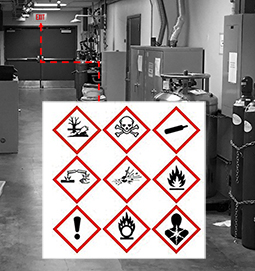Hazardous Materials Transport Requirements: Campus Intra- & Inter-Building Only

Learn the proper way to transport hazardous materials on campus.
Research projects often require movement of hazardous materials through public access ways in order to utilize critical facilities and equipment.
Hazardous materials include chemical, biological, radioactive and physical materials that present a risk to people or property from their inherent nature. Materials presenting a physical hazard are primarily comprised of compressed gas cylinders that have contents under pressure or extreme temperatures.
Materials that are restricted from this policy include those that present an unacceptable risk to persons involved in transport and persons in non-laboratory areas along the transport route. If movement is required please contact Environment, Health
- Explosive
- Pyrophoric
- Water Reactive
- Shock sensitive materials
- BSL 3 agents
- Radioactive Materials – contact your Health Physicist for guidance on safe movement
Researchers must be fully aware of the hazards of the materials they are transporting – this includes reviewing Safety Data Sheets (SDS), if applicable.
Important: These procedures only apply to the movement of hazardous materials within a building or between adjacent campus buildings.
Required Training
All researchers handling hazardous materials are required to complete and remain current with all required laboratory safety training.
This includes the completion of initial training and all required refresher courses.
Selection of Appropriate Secondary Containment for Transfer
When transporting hazardous materials through public spaces it is critical that secondary containment is provided for the material. The purpose of the secondary container is to prevent spills of or exposures to the material during transport.
The selected container should meet all of the following criteria:
- Easily cleanable
- Can be closed
- Break-resistant
- Volume is equal to 110% or greater of the hazardous material transported
Utilize carts when possible to reduce the chances of dropping material. Cart use does not negate the requirement for use of a secondary container.
Moving the Materials
The following requirements apply to the movement of hazardous materials:
- Secondary containment is required.
- Never leave materials unattended at any time.
- Gloved hands are not to contact any surface outside of the lab. Secondary containers should be decontaminated by laboratory personnel as necessary prior to movement to pre-empt the need for gloves.
- Utilize freight elevators when possible. If not possible, advise other passengers of the presence of hazardous materials prior to their entering the passenger elevator.
- Have an appropriate spill kit available during the material movement.
Prior to moving material choose a route that minimizes risk to others. Considerations to make include not passing through break or lunch areas.
Requirements for Compressed and Liquefied Gas
When transporting compressed gas cylinders, the cylinder must be chained to a suitable gas cylinder hand truck and the valve must be protected with a cover cap. Gas cylinders must never be left unattended.
When transporting cylinders or tanks in an elevator additional passengers are prohibited. See the Transporting Compressed Gas page for more information on moving these materials.
Requirements for Biohazardous Waste
You must transport biohazardous waste in double red bags held in rigid, closed, leak-proof containers with biohazard labels on the top and side. Biohazardous waste must be under direct control of the responsible laboratory until it is placed in an EH&S approved storage area.
Hand carrying bags or bags on open carts are strictly prohibited.